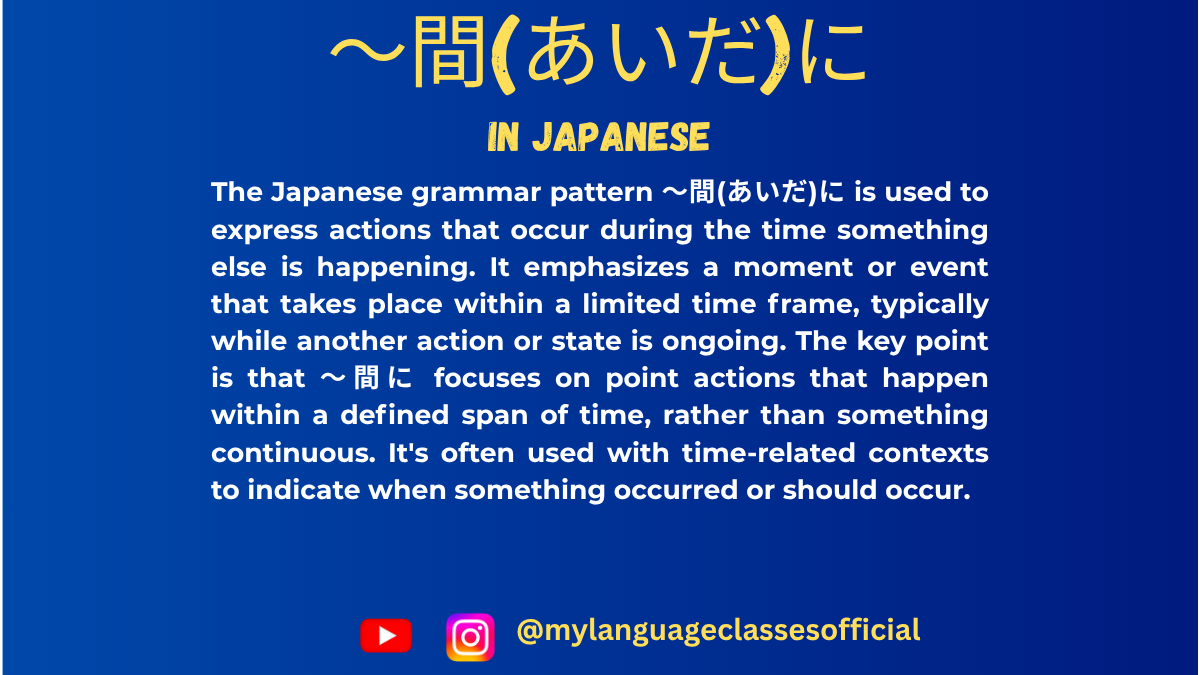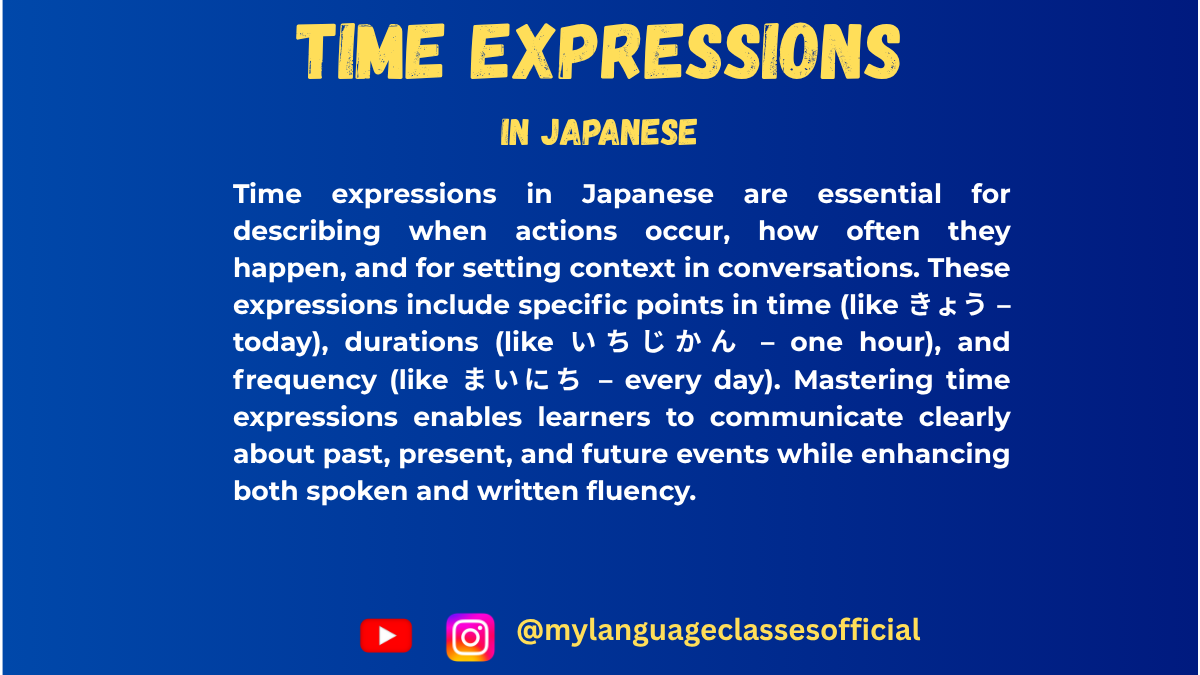Your cart is currently empty!
Tag: Japanese time-related phrases
-

Using 〜間(あいだ)に in Japanese | My Language Classes
How to Use 〜間(あいだ)に in Japanese
The phrase “〜間(あいだ)に” is an important grammatical structure in Japanese that signifies an action that occurs within a specific time frame or during another ongoing action. In this blog post, we will explore all the possible usages of “〜間に,” provide example sentences, practice exercises, and conclude with essential points to remember.
Situations Where 〜間(あいだ)に is Used
- An event occurring within a specified time frame:
- This indicates that something happens while another action or state continues for a limited duration.
- An event occurring before another event finishes:
- The action expressed in “〜間に” must be completed within the time frame of the main action.
- Unexpected occurrences:
- Sometimes, something unplanned or sudden happens within the given time span.
- Used with verbs in their progressive (〜ている) or non-progressive forms:
- The verb preceding “間に” can be in its progressive (e.g., 勉強している間に) or simple form (e.g., 勉強する間に), but the nuance changes slightly.
Example Sentences with Romaji and English Translation
- 母は買い物をしている間に、私は家の掃除をしました。
Haha wa kaimono o shite iru aida ni, watashi wa ie no souji o shimashita.
(While my mother was shopping, I cleaned the house.) - 私がシャワーを洗っている間に、妻は昼ごはを作っていました。
Watashi ga shawaa o aratte iru aida ni, tsuma wa hirugohan o tsukutte imashita.
(While I was taking a shower, my wife was making lunch.) - 休憩している間に、メールを確認した。
Kyuukei shite iru aida ni, meeru o kakunin shita.
(While I was taking a break, I checked my email.) - 先生がお話している間に、学生たちはメモをとった。
Sensei ga ohanashi shite iru aida ni, gakusei-tachi wa memo o totta.
(While the teacher was talking, the students took notes.)
Fill in the Blanks Exercise
- 私がテレビを見ている____, 妹は引き出しを整理していた。
- 父が電話をしている____, 子供たちは遊んでいた。
Answers:
- 間に
- 間に
Things to Keep in Mind
- The phrase “〜間に” always denotes an action that happens within the specified period.
- The action occurring within “〜間に” must be completed before the main event ends.
- It is different from “〜間” without “に” which focuses on continuity rather than completion.
- “〜間に” is often used for brief actions rather than prolonged ones.
- Some verbs are naturally suited for this structure, like 見る (miru, to see), 読む (yomu, to read), etc.
Conclusion
Mastering “〜間に” is crucial for understanding Japanese time expressions. This structure allows speakers to describe events occurring within a specific time frame accurately. By practicing with examples and exercises, learners can improve their fluency and comprehension. Keep practicing, and soon, using “〜間に” will become second nature!
If you enjoyed this lesson, be sure to check out more posts like this on my blog at My Language Classes. Don’t forget to subscribe my YouTube channel and follow me on Instagram for the latest language learning tips and lessons. Leave a comment below to share your thoughts, or ask any questions you have about nouns.
Happy learning! 😊
- An event occurring within a specified time frame:
-

Time Expressions in Japanese, Days of the Week, Date | My Language Classes
Mastering Time Expressions in Japanese
Mastering time expressions in Japanese is essential for effective communication. Whether you’re discussing plans, recounting past events, or simply trying to understand the time, having a grasp of Japanese time vocabulary will make your conversations smoother and more precise. This guide will walk you through everything from days and dates to time particles and duration expressions.
1. Days of the Week in Japanese
Days of the Week
Understanding the days of the week in Japanese is fundamental when learning how to tell time in Japanese:
- 月曜日 (げつようび) – Monday
- 火曜日 (かようび) – Tuesday
- 水曜日 (すいようび) – Wednesday
- 木曜日 (もくようび) – Thursday
- 金曜日 (きんようび) – Friday
- 土曜日 (どようび) – Saturday
- 日曜日 (にちようび) – Sunday
To express “on a specific day,” simply add the particle “に” after the day name:
- 月曜日に会いましょう。
(げつようびに あいましょう)
Let’s meet on Monday.
Dates in Japanese
The Japanese date format is Year + Month + Day. Here’s how to say dates in Japanese:
- Year: 2024年 (2024ねん)
- Month: 1月 (いちがつ) – January
- Day: 1日 (ついたち) – 1st
Example:
- 2024年12月24日 (2024ねん 12がつ 24にち) – December 24, 2024.
Special Days
- 今日 (きょう) – Today
- 明日 (あした) – Tomorrow
- 昨日 (きのう) – Yesterday
2. Hours and Minutes in Japanese
Japanese Hours
To express hours, use the counter ~時 (~じ):
- 1時 (いちじ) – 1 o’clock
- 2時 (にじ) – 2 o’clock
Japanese Minutes
For minutes, use the counter ~分 (~ふん/~ぷん):
- 1分 (いっぷん) – 1 minute
- 5分 (ごふん) – 5 minutes
Example:
- 今は3時15分です。
(いまは さんじ じゅうごふん です)
It is 3:15 now.
3. Relative Time Expressions in Japanese
Past, Present, and Future
- 今 (いま) – Now
- さっき – A moment ago
- 後で (あとで) – Later
- もうすぐ – Soon
Example:
- 今、テレビを見ています。
(いま、てれびを みています)
I am watching TV now.
Frequency Expressions in Japanese
- 毎日 (まいにち) – Every day
- 時々 (ときどき) – Sometimes
- よく – Often
- たまに – Occasionally
4. Japanese Time Particles: に, まで, and から
に (ni)
The particle “に” is used for specific points in time:
- 午後5時に会いましょう。
(ごご ごじ に あいましょう)
Let’s meet at 5 PM.
まで (made)
“まで” indicates “until” a point in time:
- 5時まで働きます。
(ごじまで はたらきます)
I work until 5 o’clock.
から (kara)
“から” means “from” a point in time:
- 9時から会議があります。
(くじ から かいぎ が あります)
There is a meeting from 9 o’clock.
5. Expressing Duration in Japanese
To express duration, use ~時間 (~じかん) for hours and ~分間 (~ふんかん) for minutes:
- 2時間 (にじかん) – 2 hours
- 30分間 (さんじゅっぷんかん) – 30 minutes
Example:
- 3時間勉強しました。
(さんじかん べんきょうしました)
I studied for 3 hours.
6. Common Japanese Time-Related Phrases
- What time is it?
今何時ですか?
(いま なんじ ですか) - At what time will you arrive?
何時に着きますか?
(なんじ に つきますか) - I will arrive at 8 o’clock.
8時に着きます。
(はちじ に つきます)
Tips for Learning Time Grammar in Japanese
- Master the Particles: Words like に, まで, and から are vital for expressing time accurately.
- Practice Pronunciation: Be mindful of counters like 分 (ふん/ぷん) which change pronunciation based on the preceding number.
- Learn Contextual Usage: Time expressions in Japanese can vary between casual and formal contexts. For instance, 今 (now) is common in casual settings, while 現在 (げんざい) is used in formal situations.
By incorporating these Japanese time expressions for beginners into your daily practice, you’ll build confidence and fluency. Don’t forget to share your favorite Japanese time phrases list or ask questions in the comments below. Happy learning! 今日も頑張りましょう! (Let’s do our best today!)
If you enjoyed this lesson, be sure to check out more posts like this on my blog at My Language Classes. Don’t forget to subscribe my YouTube channel and follow me on Instagram for the latest language learning tips and lessons. Leave a comment below to share your thoughts, or ask any questions you have about nouns.
Happy learning! 😊
